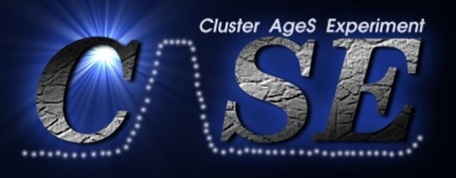|

|
|
The Cluster AgeS Experiment (CASE) is a long term project aiming at determination of accurate ages and distances of nearby globular clusters (GC) by using observations of detached eclipsing binaries. The project consists of two parts. The first part is an extensive photometric survey of about 10 Galactic GCs with the aim of identifying eclipsing binaries (EB) located near or below the main-sequence turnoff (MSTO). The survey is conducted on the 1.0-m Swope telescope at Las Campanas Observatory. The second part of the project is devoted to determination of absolute parameters (masses, radii, ages and luminosities) of selected EBs. It includes derivation of precise radial velocity curves as well as photometric follow up observations in the optical and near IR domain. Eclipsing binaries hold great promise as primary distance and age indicators (Paczynski, 1996; Kruszewski & Semeniuk, 1999). They can be used for establishing accurate distances to globular clusters as well as to galaxies in the Local Group. Binaries most suitable for the determination of ages of globular clusters are detached systems hosting primaries which have already finished their evolution on the main-sequence. In such a case the age can be calculated directly from the age-turnoff mass relation based on stellar models. The first practical application of this method was presented recently by Thompson et al., 2001 (also link to astroph). Attempts to use binaries for the derivation of distances and ages of globular clusters have been hampered till recently by the paucity of suitable systems. To change this situation a long term project named CASE was established. It is a collaboration of astronomers from Carnegie Observatories (Pasadena, USA) and Copernicus Astronomical Center (Warsaw, Poland).

Panorama of the Las Campanas Observatory. The domes, from left to right, house 2.5-m du Pont telescope, 1.3-m Warsaw telescope, 1.0-m Swope telescope and two 6.5-m Magellan telescopes. The survey part of the project is conducted mostly at the Las Campanas Observatory with the du Pont and Swope telescopes. On the Swope telescope we obtain extensive time series photometry using 2x4K SITE CCD with an effective FoV 14.5x22.5 arcmin2. The Du Pont telescope is used mostly for obtaining follow-up visual and IR photometry of already identified binaries. The project started in 1996 and it is usually allocated 30-50 nights of telescope time per year. So far we have concluded the survey for 10 globular clusters, collecting the equivalent of 6-20 nights of data per object. The second part of the project is devoted to determination of absolute parameters (masses, radii, ages and luminosities) of selected EBs. It includes derivation of precise radial velocity curves as well as photometric follow up observations in the optical and near IR domain. The spectroscopic data are currently being collected, mainly using the 6.5-m Clay and Baade telescopes at Las Campanas Observatory. |
Accessibility Statement | Webmaster: pych@camk.edu.pl